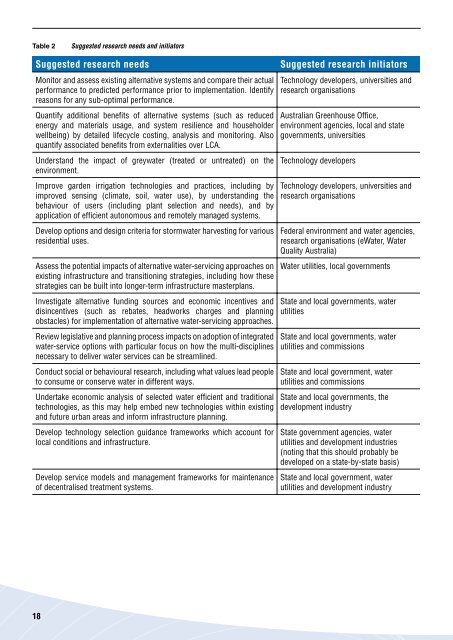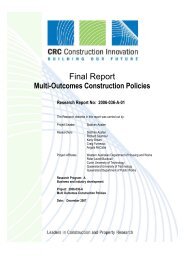Table 2Suggested research needs and initiatorsSuggested research needsMonitor and assess existing alternative systems and compare their actualperformance to predicted performance prior to implementation. Identifyreasons for any sub-optimal performance.Quantify additional benefi ts of alternative systems (such as reducedenergy and materials usage, and system resilience and householderwellbeing) by detailed lifecycle costing, analysis and monitoring. Alsoquantify associated benefi ts from externalities over LCA.Understand the impact of greywater (treated or untreated) on theenvironment.Improve garden irrigation technologies and practices, including byimproved sensing (climate, soil, water use), by understanding thebehaviour of users (including plant selection and needs), and byapplication of effi cient autonomous and remotely managed systems.Develop options and design criteria for stormwater harvesting for variousresidential uses.Assess the potential impacts of alternative water-servicing approaches onexisting infrastructure and transitioning strategies, including how thesestrategies can be built into longer-term infrastructure masterplans.Investigate alternative funding sources and economic incentives anddisincentives (such as rebates, headworks charges and planningobstacles) for implementation of alternative water-servicing approaches.Review legislative and planning process impacts on adoption of integratedwater-service options with particular focus on how the multi-disciplinesnecessary to deliver water services can be streamlined.Conduct social or behavioural research, including what values lead peopleto consume or conserve water in different ways.Undertake economic analysis of selected water effi cient and traditionaltechnologies, as this may help embed new technologies within existingand future urban areas and inform infrastructure planning.Develop technology selection guidance frameworks which account forlocal conditions and infrastructure.Develop service models and management frameworks for maintenanceof decentralised treatment systems.Suggested research initiatorsTechnology developers, universities andresearch organisationsAustralian Greenhouse Offi ce,environment agencies, local and stategovernments, universitiesTechnology developersTechnology developers, universities andresearch organisationsFederal environment and water agencies,research organisations (eWater, WaterQuality Australia)Water utilities, local governmentsState and local governments, waterutilitiesState and local governments, waterutilities and commissionsState and local government, waterutilities and commissionsState and local governments, thedevelopment industryState government agencies, waterutilities and development industries(noting that this should probably bedeveloped on a state-by-state basis)State and local government, waterutilities and development industry18
ReferencesReferencesAlternative Technology Association (2005) GreywaterProject Report, http://www.ata.org.au/wp-content/projects/smartwater_fi nal_report.pdfArgue, JJ and Argue, JR (1998) Total stormwatermanagement at Figtree Place, Newcastle, New SouthWales. Proceedings of 3rd International Conferenceon Innovative Technologies in Urban Storm Drainage,GRAIE, Lyon, FranceAtlantis Water Management (2007) Storm waterfi ltration & re-use system, http://www.atlantiscorp.com.au/projects/storm_water_fi ltration_&_reuse_systemAccessed 07/05/07Australian Bureau of Statistics (2005) Feature Article- Household Water Use and Effects of the Drought.Report 1350.0 - Australian Economic Indicators,Australia, http://www.abs.gov.au/Ausstats/abs@.nsf/Lookup/A0B004E8941B6FBFCA25702F007A793BAccessed 09/05/07Australian Water Association (2005) Status of Water inSouth East Queensland for the Courier Mail,http://www.awa.asn.auAustralian Water Conservation and Reuse ResearchProgram (2004) CSIRO Land and Water, http://www.clw.csiro.au/awcrrp/stage1.html Accessed 09/05/07Brisbane City Council (2004) Water for Today andTomorrow. An Integrated Water Management Strategyfor Brisbane. Making Brisbane a Water Smart CityBrisbane City Council (2005a) Water Sensitive UrbanDesign Engineering Guidelines: Stormwater (Draft)Brisbane City Council, Brisbane, http://www.brisbane.qld.gov.au/BCC:BASE:1220649970:pc=PC_1898Accessed 09/05/07Brisbane City Council (2005b) Water for today andtomorrow: a Proposed Integrated Water ManagementStrategy for Brisbane: Consultation Draft, datedNovemberCity of Melbourne (2004) Water Sensitive Urban DesignGuidelines, http://www.melbourne.vic.gov.au/rsrc/PDFs/Water/WSUDGuidelines.rtfClarke, JM and Brown, RR (2006) Understanding thefactors that infl uence domestic water consumptionwithin Melbourne, Proceedings of 7th Urban DrainageModeling and 4th Water Sensitive Urban DesignConference, MelbourneDepartment of Local Government, Planning, Sport andRecreation (2004) Towards <strong>Sustainable</strong> Housing inQueensland: Discussion paper, http://www.lgp.qld.gov.au/?id=2291 Accessed 09/05/07Department of Natural Resources and Mines (2006)South East Queensland Regional Water Supply StrategyStage 2 Interim ReportDiaper, C, Tjandraatmadja, G and Kenway, S (2006)<strong>Sustainable</strong> <strong>subdivisions</strong>: Review of technologiesfor integrated water services (Research report), CRC<strong>Construction</strong> <strong>Innovation</strong> Report, September 2006, http://www.construction-innovation.info/index.php?id=361Diaper, C, Sharma, A, Gray, S, Mitchell, G and Howe, C(2003) Technologies for the provision of infrastructure tourban developments – Canberra Case Study, CSIRO MITTechnical Report 2003-183Dillon, P, Pavelic P, Toze S, Rinck-Pfeiffer, S, Martin,R, Knapton, A and Pidsley, D (2006) Role of aquiferstorage in water reuse, Desalination Vol: 188, Issue: 1–3,Integrated Concepts in Water Recycling, 14–17 February2005Gardner, T and Millar, G (2003) The performance of agreywater system at the Healthy Home in South EastQueensland – three years of data, Proceedings ofOn Site-’03 Conference Future Directions for On-sitesystems: best management practice, University of NewEngland, 30 September – 2 October, Lanfax LaboratoriesGardner, T, Baisden, J and Miller, G (2004) Rainwaterfi rst fl ush devices: Are they effective? ConferenceProceedings, <strong>Sustainable</strong> Water in the UrbanEnvironment, August, Sunshine Coast, QueenslandGardner, T, Millar, G, Christiansen, C, Vieritz, A andChapman, H (2006) Urban metabolism of an ecosensitivesubdivision in Brisbane, Australia, Proceedingsof Enviro 06, 9–11 May, MelbourneGeolink (2005) Clunes Wastewater – Assessment ofOnsite and Community-Scale Wastewater ManagementOptions, http://www.geolink.net.au/infocentre/index.htmlGray, S (2004) Comparison of on-site greywater systemsand raintanks for reticulated water demand reduction inurban environments, Proceedings of IWA 6th SpecialistConference of Small Water and Wastewater Systems,11–13 February, Murdoch University, Fremantle, WAHatt, B, Deletic, A and Fletcher, T (2004) IntegratedStormwater Treatment and Reuse Systems, Inventory ofAustralian Practice, CRC Catchment Hydrology IndustryReportHurlimann, A and McKay, J (2003) Community Attitudesto an Innovative Dual Water Supply System at MawsonLakes, South Australia, Proceedings from Ozwater 2003,Perth, 6–10 AprilHurlimann, A and McKay, J (2004) Attitudes toReclaimed Water for Domestic Use: Part 2. Trust, Water,Journal of the Australian Water Association,31 (5): 40–4519
















